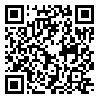Volume 13, Issue 2 (2024)
JFST 2024, 13(2): 13-25 |
Back to browse issues page
Download citation:
BibTeX | RIS | EndNote | Medlars | ProCite | Reference Manager | RefWorks
Send citation to:



BibTeX | RIS | EndNote | Medlars | ProCite | Reference Manager | RefWorks
Send citation to:
Sheykhnezhad E, Adeli A, Alishahi A. Evaluating the consumer’s behavior of farmed carps in the northern provinces of the country using structural equation model. JFST 2024; 13 (2) :13-25
URL: http://jfst.modares.ac.ir/article-6-72470-en.html
URL: http://jfst.modares.ac.ir/article-6-72470-en.html
1- PhD student, Department of Processing of Fishery Products, Faculty of Fisheries and Environment, Gorgan University of Agricultural Sciences and Natural Resources
2- Associate Professor, Department of Processing of Fishery Products, Faculty of Fisheries and Environment, Gorgan University of Agricultural Sciences and Natural Resources ,afshinadeli@yahoo.com
3- Associate Professor, Department of Processing of Fishery Products, Faculty of Fisheries and Environment, Gorgan University of Agricultural Sciences and Natural Resources, Gorgan,
2- Associate Professor, Department of Processing of Fishery Products, Faculty of Fisheries and Environment, Gorgan University of Agricultural Sciences and Natural Resources ,
3- Associate Professor, Department of Processing of Fishery Products, Faculty of Fisheries and Environment, Gorgan University of Agricultural Sciences and Natural Resources, Gorgan,
Abstract: (837 Views)
Aims: The purpose of this research was to evaluate the consumer’s behavior of farmed carp in the north of Iran (Golestan, Mazandaran and Gilan province). Method: After defining the assumptions and designing the analytical-conceptual model based on the theory of planned behavior, a suitable questionnaire was developed and completed by the statistical community. In order to evaluate the intensity of the relationship between the research variables and the model elements, as well as to check the acceptance or non-acceptance of the assumptions, the structural equation modeling method (SEM) was used. Findings: Per capita fish consumption of farmed carp consumers is 5.3 kg. Of this amount, 400 grams are canned, 600 grams are consumed in restaurants and outside the home, and 2.5 kg are consumed at home. Per capita consumption of their farmed carp is 1.4 kg, so half of their consumption is from other fish.In this research, all hypotheses were confirmed, In this way, the effect of perceived usefulness, perceived risk and quality on attitude, the effect of normative beliefs, moral obligation and household income on subjective norms, the effect of control power, control belief, experimental records, advertising and education on the perceived behavior control, the effect of attitude, subjective norms and perceived behavior control on the decision to buy farmed carp and the effect of the decision to buy and perceived behavior control on the final behavior were reported to be significant (p<0.05). The values of the effect coefficients showed that the most effective variable on the attitude, subjective norms and perceived behavior control, is quality (with an effect coefficient of 0.46), income (with an effect coefficient of 0.44) and experience records (with an effect coefficient of 0.37), respectively. Also, among the three main elements of the model, the attitude had the greatest effect on the decision to buy and consume farmed carp (with an effect coefficient of 0.48).
Article Type: Original Research |
Subject:
Aquatic Environment Management
Received: 2023/11/16 | Published: 2024/07/1
Received: 2023/11/16 | Published: 2024/07/1
Send email to the article author
| Rights and permissions | |
 |
This work is licensed under a Creative Commons Attribution-NonCommercial 4.0 International License. |







